Defining whether the foods we eat are actually good for us is a noisy, messy business. That’s why the US government is looking to make some rules.
The US Food and Drug Administration is reworking its approach to the claims food companies use on product packaging. In what way is a bag of Lay’s thick-cut sea salt potato chips ”natural?” The same question applies to a lot of snack foods labeled as ”healthy.”
Those questions will soon have answers. The FDA this week (May 10) finished collecting input on how it should define the term ‘natural’—which is being used with reckless abandon on supermarket shelves since the claim isn’t regulated. The agency also plans to tinker with its definition of ‘healthy,’ following a March 2015 dispute with KIND Bars.
Agency officials have said the department’s guidelines are due for reevaluation in light of evolving nutrition research (including the latest iteration of the US Dietary Guidelines), but with so many competing interests at stake it will likely be the subject of much hand-wringing and consternation among food industry giants and public health groups.
“I would say listen to the doctors and the scientists, don’t listen to the industry players,” said Daniel Lubetzky, the CEO of KIND Bars. “Listen to the people who have no bias, let them set the stage. Don’t let anyone politicize this.”
Of course, everyone has bias, including Lubetzky. After all, his company made headlines last year when the FDA told it to stop printing “healthy” on its snack bar packaging. Lubetzky claims the almonds in his products pushed the fat content over the 3-gram limit. Other health advocates say it had more to do with the palm kernel oil used for some of the bars’ chocolate coating.
The current FDA definition of ‘healthy’ doesn’t distinguish much between so-called good fats and bad fats, which can distort how its regulations play out. For instance, a bar loaded with fatty almonds might not be allowed to be a ”healthy” product, but a non-fat cup of pudding would make the cut.
No good answer
The forthcoming definitions for ‘natural’ and ‘healthy’ may not address all the outstanding questions about what constitutes good food. The Grocery Manufacturers Association (GMA)—which represents multinational food corporations that include Mars, PepsiCo and Nestlé— has already said farming and agricultural methods should have no bearing on the ‘natural’ claim. That means pesticide use, animal welfare practices and use of genetically-engineered plant seeds wouldn’t impact use of the claim. From the GMA’s letter to the FDA:
The criteria used to determine if a food qualifies for a ‘natural’ claim should focus primarily on whether the product’s ingredients are synthetic/artificial or natural and on the degree of processing the ingredients have undergone.
The questions are so big and unwieldy that some groups, including non-profit health advocacy group the Center for Food Safety, say the FDA should prohibit use of ‘natural’ altogether.
Other health advocates point out that the really healthy foods in supermarkets have no labels at all, and don’t come in packages. In that sense, cutting down on labeled foods altogether is what promotes healthy eating, says Bonnie Liebman, director of nutrition at the Center for Science in the Public Interest. “Convincing the public that half their plate should be filled with fruits and veggies is far more important than filling their plate with processed foods.”
